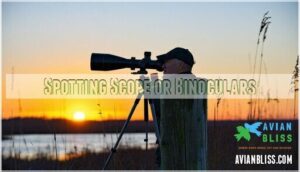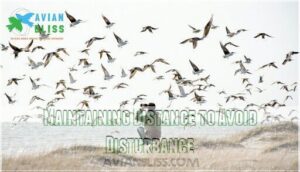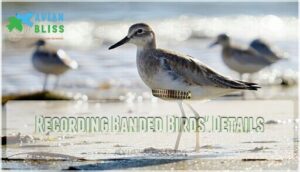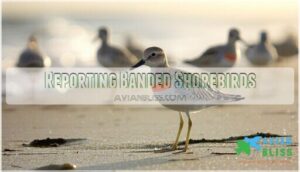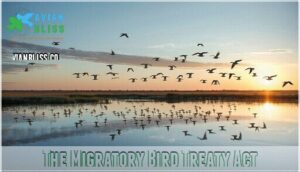This site is supported by our readers. We may earn a commission, at no cost to you, if you purchase through links.

These feathered travelers are creatures of habit, timing their arrivals with the tides. Your sweet spot is around high tide when rising waters push birds closer to shore, concentrating them in smaller areas where they’re easier to observe.
As the tide retreats, freshly exposed sand reveals new feeding opportunities, keeping birds active and visible. Early morning hours often provide the most action, as shorebirds are naturally more active after a night’s rest.
The right timing can transform an ordinary beach walk into an extraordinary wildlife spectacle filled with identification challenges.
Table Of Contents
Key Takeaways
- You’ll spot the most shorebirds during spring migration from late March through early June, when thousands of birds make their journey north to breeding grounds and display their stunning breeding plumage.
- Time your visits around high tide to see birds concentrated closer to shore, then watch as receding waters expose fresh feeding areas that keep shorebirds active and visible.
- Bring quality binoculars or a spotting scope to read tiny leg bands from a respectful 50-meter distance, and contribute to conservation by reporting banded bird sightings to research databases.
- Plan early morning visits when shorebirds are most active after their night’s rest, and you’ll transform an ordinary beach walk into an extraordinary wildlife spectacle filled with identification opportunities.
Best Time for Spotting Shorebirds
You’ll catch the most spectacular shorebird action during spring migration from late March through early June, when thousands of these feathered travelers make their epic journey north to breeding grounds.
Think of it as nature’s version of rush hour traffic, except instead of honking cars, you’ll witness sandpipers, plovers, and other remarkable species refueling at coastal stopover sites before continuing their incredible transcontinental flights.
Migration season transforms quiet coastlines into bustling avian highways filled with feathered travelers.
Spring Migration on Long Island, New York
Long Island’s coastline transforms into a shorebird superhighway each spring, attracting thousands of migrants during peak migration times from April through May.
You’ll discover incredible species identification opportunities as these feathered travelers pause to refuel in diverse Long Island habitats like Jamaica Bay and Montauk Point.
Here’s your spring migration game plan:
- Scout local birding spots early morning when birds are most active and temperatures are cooler
- Time visits with high tides to concentrate flocks closer to shore for better viewing
- Maintain 50-meter distance from flocks to avoid disturbance during this critical refueling period
- Document banded birds by recording band colors, codes, and leg positions for coastal conservation efforts
This shorebird migration spectacle supports essential research through citizen science participation.
Late March to Early June
The sweet spot for catching spring migration action runs from late March through early June, when shorebirds transform coastal habitats into bustling pit stops.
You’ll witness peak abundance during this window as thousands of birds showcase their stunning breeding plumage while making essential migration stopovers.
Early arrivals appear in late March, but peak migration hits in late April and May when bird migration patterns align perfectly with favorable weather conditions.
| Month | Migration Activity | Best Species to Spot |
|---|---|---|
| Late March | Early arrivals begin | Killdeer, some sandpipers |
| April | Peak migration timing | Red knots, dunlin |
| May | Breeding plumage peak | Sanderlings, turnstones |
| Early June | Late stragglers | Semipalmated sandpipers |
| Mid-June | Nesting behaviors begin | Local breeding species |
This shorebird migration timing creates unforgettable viewing opportunities.
Thousands of Shorebirds
During peak migration timing from late March to early June, you’ll witness incredible shorebird abundance that transforms mudflats into bustling airports.
Over 15,000 Red Knots alone use Long Island as their migration highway, creating spectacular migration spectacles.
These massive gatherings showcase fascinating flock dynamics as different species sort themselves by feeding preferences and social behaviors.
However, such habitat congestion presents conservation challenges, as thousands of birds compete for limited food resources in increasingly developed coastal areas.
Understanding these bird migration patterns helps you appreciate why protecting stopover sites matters so much for bird behavior and survival during these epic journeys.
Spring migration typically peaks late April, offering ideal viewing opportunities.
Banded Shorebirds and Research
During spring migration, you’ll spot shorebirds wearing colorful bands around their legs—tiny jewelry that tells incredible stories.
These bands serve multiple banding purposes, from tracking migration patterns to monitoring population health.
Modern banding techniques use lightweight, corrosion-resistant materials that don’t harm the birds.
Your observations contribute to essential data collection efforts, helping researchers understand how climate change affects these travelers.
This citizen science approach transforms casual birdwatching into meaningful conservation efforts that protect shorebird populations worldwide.
Reporting Re-sightings of Banded Birds
After spotting banded birds during migration, you become part of essential citizen science efforts.
Your reports help researchers track migration routes and support conservation efforts.
Here’s how to contribute:
- Document band identification details including color, number, and leg position
- Record precise location, date, and flock size for accurate data collection
- Photograph the band if possible for verification
- Submit findings through official reporting methods to maximize research impact
Equipment Needed for Viewing Banded Shorebirds
You’ll need a spotting scope or high-quality binoculars to read the tiny color bands and metal tags on shorebirds’ legs from a respectful distance.
Think of yourself as a detective solving puzzles, since each band combination tells a unique story about where that bird has traveled during its incredible migration journey.
Spotting Scope or Binoculars
Reading those tiny bands requires the right optics.
Your choice between spotting scopes and binoculars depends on your birdwatching style and budget.
Here’s what matters most:
| Feature | Spotting Scopes | Binoculars |
|---|---|---|
| Magnification Power | 20-60x zoom capability | Fixed 8-12x magnification |
| Field of View | Narrow but detailed | Wider viewing area |
| Weatherproofing | Heavy-duty protection | Lightweight durability |
| Image Stabilization | Tripod-mounted stability | Hand-held convenience |
Quality lens coatings enhance clarity for successful shorebird identification during migration peaks.
For the best birding experience, consider a spotting scope with an 80-85mm objective lens.
Maintaining Distance to Avoid Disturbance
Stay back at least fifty meters from shorebird flocks—you’ll avoid stress-induced flyaways while still capturing great photos.
Ethical birding means crouching low and moving slowly to minimize impact on these exhausted migrants.
Selecting from top birding binoculars brands can enhance your viewing experience.
Your responsible photography and habitat protection efforts help guarantee future generations can observe respectfully. Think of it as giving tired travelers the space they desperately need to refuel for their incredible journeys ahead.
Recording Banded Birds’ Details
Every detail matters when documenting banded birds during migration.
Use your binoculars to identify the band color, material, and any visible codes or numbers.
Note the band location on which leg it’s attached.
Record the date, exact location, weather conditions, and flock size for accurate data submission.
Your bird identification skills contribute to essential research purpose, helping scientists track shorebird migration patterns.
Consider using banded bird binoculars for enhanced viewing.
Take photos when possible, but prioritize clear written observations for birdwatching documentation.
Reporting Banded Shorebirds
Once you’ve recorded those band combinations, it’s time to share your findings with the scientific community. Your data submission becomes part of a larger citizen science effort that tracks shorebird populations and migration patterns.
Here’s how to make your birdwatch count:
- Report Piping Plover sightings directly to species-specific research programs
- Submit American Oystercatcher re-sightings through their dedicated online portal
- Use the Bird Banding Laboratory’s central database for all other banded birds
- Include date, location, behavior, and complete band details in your reports
Understanding banding purposes helps you appreciate why researchers need this information. Consider using a band reporting database for streamlined data entry. Your observations contribute real research impact by helping scientists map migration routes, monitor survival rates, and identify habitat needs. It’s like being a detective – every band tells a story about where that bird has traveled, making each observation a valuable part of migration patterns and habitat needs research.
Opportunities for Bird Conservation During Migration
You can help protect shorebirds while watching them during migration season through simple conservation actions and citizen science projects.
These efforts support research that’s essential for understanding migration patterns and ensuring these remarkable travelers continue their ancient journeys for future generations to enjoy, which is crucial for their migration.
The Migratory Bird Treaty Act
Since 1918, the Migratory Bird Treaty Act has been your shorebirds’ best friend during migration season.
This groundbreaking treaty history between the U.S., Canada, Mexico, Japan, and Russia created the legal backbone protecting over 1,000 bird species.
The act provisions prohibit hunting or disturbing migratory birds without permits, while enforcement measures include fines up to $15,000 per violation.
Its conservation impact helped save species like the Snowy Egret from extinction.
Future challenges include habitat loss and climate change affecting bird migration patterns you’ll witness during birdwatching adventures.
Getting Involved in Bird Conservation
You can make a real difference in shorebird conservation through multiple pathways that protect these incredible migrators.
Over 70% of bird conservation organizations depend on volunteers like you to keep their essential work running smoothly.
Consider volunteering for bird banding projects during migration to get hands-on experience with conservation research:
- Habitat Restoration – Plant native species that create feeding havens for hungry travelers
- Citizen Science – Submit your eBird observations to help scientists track population trends
- Policy Advocacy – Support legislation protecting critical stopover sites from development
- Reducing Threats – Remove invasive plants that crowd out shorebird food sources
- Sustainable Practices – Choose eco-friendly products that keep coastal waters clean
Your conservation efforts directly support shorebird populations during their most vulnerable moments.
Protecting these species involves strategic habitat management.
The Year of The Bird
You can tap into the Year of the Bird initiative to support shorebird conservation during migration seasons.
This global movement connects birdwatchers with Habitat Conservation efforts through Citizen Science projects that track Migration Patterns and address Conservation Challenges.
| Conservation Action | Impact Level | Your Role |
|---|---|---|
| Report banded shorebirds | High | Bird Identification recorder |
| Join migration counts | Medium | Citizen Science volunteer |
| Share birdwatching photos | Low | Conservation advocate |
| Support habitat protection | High | Donor/activist |
| Educate others about migration | Medium | Community educator |
Choosing The Right Scope for Birdwatching
You’ll need quality optics to spot those tiny leg bands and distinguish between similar species during spring migration, but choosing the right scope doesn’t have to break your bank account.
Whether you’re watching nearby plovers with binoculars or tracking distant godwits with a spotting scope, the key is matching your equipment to your birding style and budget.
Scope Options for Every Budget
You don’t need to break the bank for quality birdwatching optics. Budget binoculars like the Celestron Ultima 80 and Nikon Prostaff 5 offer excellent 20-60x magnification without emptying your wallet.
Mid-range scopes such as the Vortex Diamondback provide enhanced clarity for serious birdwatchers. High-end optics like Swarovski ATX deliver professional-grade performance but cost substantially more.
Consider used scopes from reputable dealers to stretch your budget further. Essential scope features include waterproof construction and multi-coated lenses.
Every birdwatching equipment investment should match your commitment level and frequency of shorebird observation.
Binoculars for Nearby Birds
While spotting scopes excel at distance, binoculars shine when shorebirds venture close to your position. These versatile tools capture intricate feather patterns and behaviors that’d otherwise slip by unnoticed.
Close-Focus Binoculars let you observe birds just feet away, revealing details like bill textures and eye colors. Magnification Power between 8x and 10x provides a perfect balance—enough zoom without sacrificing stability. Quality Lens Coatings guarantee bright, crisp images even during overcast mornings when shorebirds are most active.
Consider these features for your birdwatching adventures:
- Ergonomic Design prevents hand fatigue during extended sessions
- Waterproof construction withstands coastal spray and rain
- Wide field of view captures flocks in motion
- Image Stabilization reduces shake for clearer viewing
- Compact size fits easily in your birding pack
- Quick-adjust eyecups accommodate glasses wearers
- Nitrogen-filled chambers prevent internal fogging
- Rubber armor provides secure grip on wet surfaces
- Phase-corrected prisms enhance color accuracy
- Lifetime warranties protect your investment
Quality birdwatching equipment transforms casual observation into meaningful discovery.
Spotting Scopes With Superior Magnification
While binoculars work well for nearby birds, spotting scopes deliver superior magnification power for distant shorebird flocks.
Quality lens systems provide crisp images at 20-60x magnification, revealing intricate plumage details impossible to see otherwise.
Weather resistance protects your investment during coastal conditions, while scope stability on tripods eliminates hand shake, and modern portability options make transport easier for dedicated birding adventures.
These powerful tools transform your birdwatching experience during peak migration periods. For ideal viewing, consider a scope with HD glass elements to minimize color distortion.
Factors to Consider When Choosing a Scope
After exploring superior magnification options, choosing the right scope means balancing several key factors.
Magnification levels between 20x-60x work best for most birdwatching situations, while lens coatings like ED glass reduce chromatic aberration for sharper images.
Scope size affects portability—larger objectives gather more light but weigh more.
Weatherproofing protects your investment during unpredictable conditions.
Tripod stability becomes critical at higher magnifications since even slight movement creates frustrating shake.
Quality optics don’t always require breaking the bank, but skimping on essential features like reliable focusing mechanisms will leave you frustrated when that rare shorebird appears.
For enhanced clarity, consider a scope with a fluorite crystal lens and look for superior magnification options, reliable focusing mechanisms, and weatherproofing to ensure a good birdwatching experience with sharp images.
Testing Multiple Models at Birding Stores or Festivals
After narrowing down your scope preferences, hands-on testing at birdwatching stores and birding events becomes your best friend. You’ll discover what online reviews can’t tell you—how each model feels in your hands and performs under real conditions.
Birdwatching festivals offer perfect opportunities for model comparison, where you can test multiple scopes side-by-side while getting expert opinions from seasoned birders.
- Test image sharpness on distant shorebirds
- Check brightness consistency across viewing fields
- Evaluate focus ring smoothness and precision
- Assess tripod stability with different models
- Compare portability between lightweight and heavy options
Store availability varies, but festival demos provide thorough birdwatching optics comparisons.
Frequently Asked Questions (FAQs)
What weather conditions affect shorebird visibility?
Weather plays a vital role in your shorebird adventures.
Calm winds and clear skies provide the best visibility, while storms can push pelagic species closer to shore.
Overcast conditions reduce glare, making identification easier.
How do tides influence shorebird feeding behavior?
Tides dramatically shape when and where you’ll find shorebirds feeding.
High tide pushes them closer to shore, while receding tides expose saturated sand that’s perfect for probing with their sensitive beaks.
Which habitats attract the most shorebird species?
Mudflats at low tide attract the most shorebird species since they expose rich feeding grounds.
You’ll also find diverse species in salt marshes, brackish water areas, sandy beaches, and estuaries where food sources are abundant.
What time of day are shorebirds most active?
Dawn and dusk absolutely steal the show for shorebird activity.
You’ll catch these feathered athletes at their busiest during these golden hours when they’re actively feeding, preening, and socializing before settling down.
How does moon phase impact shorebird movement patterns?
Moon phases dramatically affect shorebird behavior since they control tide strength and timing.
You’ll see more concentrated feeding during new and full moons when extreme tides create ideal mudflat exposure for probing.
Conclusion
Remarkably, over 50 species of shorebirds migrate through North America each spring, making timing essential for successful viewing.
You’ve learned that spring migration from late March through early June offers prime opportunities, especially during high tide when birds concentrate nearshore.
Remember to bring quality optics, respect wildlife distances, and report any banded birds you spot.
When is the best time for spotting shorebirds? Armed with this knowledge about tides, timing, and equipment, you’re ready to witness these incredible migrations firsthand.
- https://migration.fsnaturelive.org/pdf/Magnificent_Shorebird_Migration.pdf
- https://www.potomacaudubon.org/birding/pvas_birdmap/shorebirds/
- https://www.bsbo.org/timing-of-fall-shorebird-migration.html
- https://academic.oup.com/condor/article/125/2/duad003/7031074
- https://www.audubon.org/news/how-read-tides-shorebird-photography

